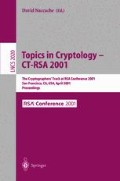Abstract
The Pintsov-Vanstone signature scheme with partial message recovery (PVSSR) is a signature scheme with low message expansion (overhead) and variable length recoverable and non-recoverable message parts. The scheme uses three cryptographic primitives: a symmetric cipher, hash function and an elliptic curve group. We give three security proofs for PVSSR in this paper. Each proof makes a concrete and necessary assumption about one primitive, and models the other two primitives by idealizations. Thus, PVSSR with a strong cipher may offer greater security than other common variants of ElGamal signatures.
Access this chapter
Tax calculation will be finalised at checkout
Purchases are for personal use only
Preview
Unable to display preview. Download preview PDF.
References
M. Abe and T. Okamoto, “A signature scheme with message recovery as secure as discrete logarithm”, Asiacrypt’99, LNCS 1716 (1999) 378–389.
W. Aiello, et al., “Security amplification by composition: the case of doublyiterated, ideal ciphers”, Crypto’98, LNCS 1462 (1998) 390–407.
M. Bellare, et al., “A concrete security treatment of symmetric encryption: Analysis of the DES modes of operation”, Proc. 38th FOCS, 1997, 394–403.
M. Bellare and P. Rogaway, “Random oracles are practical: a paradigm for designing efficient protocols”, 1st ACM Conference on Computer and Communications Security, (1993) 62–73.
M. Bellare and P. Rogaway, “The exact security of digital signatures-how to sign with RSA and Rabin”, Eurocrypt’96, LNCS 1070 (1996) 399–416.
M. Bellare and P. Rogaway, “Collision-resistant hashing: towards making UO-WHFs practical”, Crypto’97, LNCS 1294 (1997) 470–484.
R. Canetti, O. Goldreich and S. Halevi, “The random oracle methodology, revisited (preliminary version)”, Proc. 30th STOC, 1998, 209–218.
“Postage Indicia Standard” for Canada Post, Draft Version 1.2, 1999.
R. Cramer and V. Shoup, “A practical public key cryptosystem provably secure against adaptive chosen ciphertext attack”, Crypto’98, LNCS 1462 (1998) 13–25.
M. Jakobsson and C. P. Schnorr, “Security of discrete log cryptosystems in the random oracle + generic model”, presented at the Conference on The Mathematics of Public-Key Cryptography, The Fields Institute, Toronto, Canada, (1999).
D. Naccache and J. Stern, “Signing on a postcard”, Proceedings of the Fourth Annual Conference on Financial Cryptography 2000, to appear.
M. Naor and M. Yung, “Universal one-way hash functions and their cryptographic applications”, Proc. 21st STOC, ACM (1989), 33–43.
K. Nyberg and R. Rueppel, “Message recovery for signature schemes based on the discrete logarithm problem”, Designs, Codes and Cryptography, 7 (1996), 61–81.
L. Pintsov and S. Vanstone, “Postal revenue collection in the digital age”, Proceedings of the Fourth Annual Conference on Financial Cryptography 2000, to appear.
D. Pointcheval and J. Stern, “Security proofs for signature schemes”, Eurocrypt’96, LNCS 1070 (1996) 387–398.
V. Shoup, “Lower bounds for discrete logarithms and related problems”, Eurocrypt’97, LNCS 1233 (1997) 256–266.
USPS Information Based Indicia Program (IBIP): Performance Criteria for Information Based Indicia and Security Architecture for IBI Postage Metering Systems (PCIBISAIPMS), draft, 1998.
Author information
Authors and Affiliations
Editor information
Editors and Affiliations
Rights and permissions
Copyright information
© 2001 Springer-Verlag Berlin Heidelberg
About this paper
Cite this paper
Brown, D.R.L., Johnson, D.B. (2001). Formal Security Proofs for a Signature Scheme with Partial Message Recovery. In: Naccache, D. (eds) Topics in Cryptology — CT-RSA 2001. CT-RSA 2001. Lecture Notes in Computer Science, vol 2020. Springer, Berlin, Heidelberg. https://doi.org/10.1007/3-540-45353-9_11
Download citation
DOI: https://doi.org/10.1007/3-540-45353-9_11
Published:
Publisher Name: Springer, Berlin, Heidelberg
Print ISBN: 978-3-540-41898-6
Online ISBN: 978-3-540-45353-6
eBook Packages: Springer Book Archive

